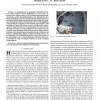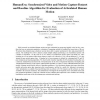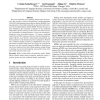134
click to vote
TSMC
2010
14 years 7 months ago
2010
Abstract--As viewpoint issue is becoming a bottleneck for human motion analysis and its application, in recent years, researchers have been devoted to view-invariant human motion a...
181
Voted
AROBOTS
2011
14 years 8 months ago
2011
— Database of human motion has been widely used for recognizing human motion and synthesizing humanoid motions. In this paper, we propose a data structure for storing and extract...
137
Voted
TVCG
2010
14 years 11 months ago
2010
—With the proliferation of motion capture data, interest in removing noise and outliers from motion capture data has increased. In this paper, we introduce an efficient human mo...
149
click to vote
IJCV
2010
14 years 11 months ago
2010
While research on articulated human motion and pose estimation has progressed rapidly in the last few years, there has been no systematic quantitative evaluation of competing meth...
117
click to vote
ICRA
2010
IEEE
14 years 11 months ago
2010
IEEE
— For a coexisting and collaborative society that incorporates humans and robots, the detection, tracking, and recognition of human motion are indispensable techniques for a robo...
118
click to vote
ICRA
2010
IEEE
14 years 11 months ago
2010
IEEE
Abstract— For many tasks in populated environments, robots need to keep track of present and future motion states of people. Most approaches to people tracking make weak assumpti...
115
click to vote
JIRS
2007
15 years 27 days ago
2007
Abstract This paper proposes a Qualitative Normalised Templates (QNTs) framework for solving the human motion classification problem. In contrast to other human motion classifica...
148
click to vote
CVIU
2007
15 years 29 days ago
2007
Markerless vision-based human motion analysis has the potential to provide an inexpensive, non-obtrusive solution for the estimation of body poses. The significant research effo...
125
Voted
CVIU
2006
15 years 1 months ago
2006
This survey reviews advances in human motion capture and analysis from 2000 to 2006, following a previous survey of papers up to 2000 [T.B. Moeslund, E. Granum, A survey of comput...
123
Voted
CVIU
2006
15 years 1 months ago
2006
We present algorithms for recognizing human motion in monocular video sequences, based on discriminative Conditional Random Field (CRF) and Maximum Entropy Markov Models (MEMM). E...



